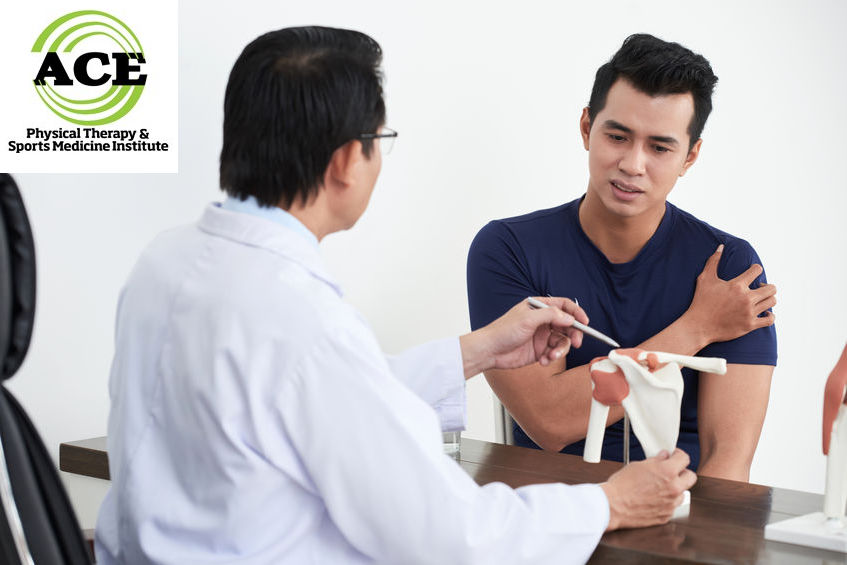SHOULDER PAIN AND POOR POSTURE

Tid Bits of Info
- Impingement syndrome can develop if someone has “rounded shoulder” posture.
- People might need help to restore the normal motion of the shoulder via manual therapy which should be performed by a Physical Therapist.
- The use of computers and cell phones can be a cause of shoulder joint pain.
- Re-establishing normal “anatomical position” posture can help to eliminate many shoulder joint problems.
- Seek the advice and treatment of a Physical Therapist if you develop shoulder pain.
Shoulder pain can limit your ability to participate in common daily activities. While there are many causes for this discomfort, shoulder pain and poor posture is common factor for many people. There is an ideal body position for both rest and movement. Unfortunately, most people do not maintain that position throughout their lifetime. When the body is not properly positioned, imbalances develop within the joints that can lead to a host of orthopaedic problems.
Healthcare professionals refer to the ideal resting body position as the “anatomical position.” This position is considered “perfect” posture and is ideal because it enables the muscles to contract and generate force to move or stabilize the body while utilizing the least amount of energy.
There is almost always a connection between shoulder pain and poor posture. The “rounded” shoulder posture can lead to numerous painful conditions. One of the most common shoulder problems is known as impingement syndrome. Impingement syndrome develops when the space under the acromion (sub-acromial space) becomes too small and the structures within the space become inflamed and painful. When the scapula (shoulder blade) does not rest in the anatomical position, it can move into a position that reduces the size of the sub-acromial space and predispose that shoulder to impingement syndrome.
The scapula should rest in the anatomical position when someone is at rest. The scapula moves in many directions to align itself with the humeral head to allow the shoulder joint to function properly. In too many individuals, the scapula moves away from the spine, rotates upwardly and tilts forward. This combination of movements reduces the size of the sub-acromial space. These movements are present when someone is said to have “rounded” shoulder posture. Due to the use of computers and cell phones in everyday life, many people develop shoulder impingement syndrome and pain.

When healthcare professionals assess painful shoulders, one of the first things that they look at is the shoulder posture. Often times the head is forward, neck rounded in the opposite direction from the anatomical position and the thoracic spine is “hunched.” All of these abnormal body part positions can lead to impingement syndrome and shoulder pain. It is imperative to correct the patient’s posture or the “problem” will not resolve. Many treatments can help to control the symptoms, but total resolution requires proper shoulder and spine posture.
Physical Therapists are some of the best healthcare professionals to visit if you develop shoulder pain. These licensed professionals can assess your status and develop program that will help you more easily attain “perfect” posture. The spine and shoulder joints will have imbalances in structures that hold them together and the muscles surrounding them. Many structures on the front of the body will be shortened and on the back, lengthened. Any muscle that is too short or too elongated will lose some of its functional capabilities due to a loss of motion and strength.
Physical Therapists use many manual techniques to help restore normal motion within joint(s) not moving properly. In many instances, there is a need to address the motion of the surrounding joints also. The body moves as a unit and all parts are relying on the other parts to move properly. In many cases of impingement syndrome, there is a need to manually stretch/mobilize the different parts of the shoulder joint to help “loosen” any restricted area. Manual therapy might be required in the neck and thoracic spine if these body parts have restricted motions. The final phase of rehabilitation needed to resolve the symptoms of impingement is to redevelop the strength and muscular endurance throughout the shoulder joint.
Shoulder pain is one of the most common complaints that healthcare professionals deal with on a daily basis. Fortunately, a good rehabilitation program can usually resolve the pain and help to re-establish the normal function of the shoulder.
























